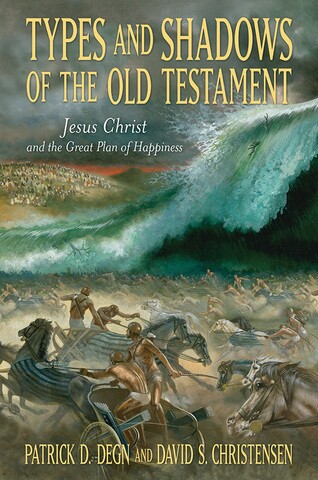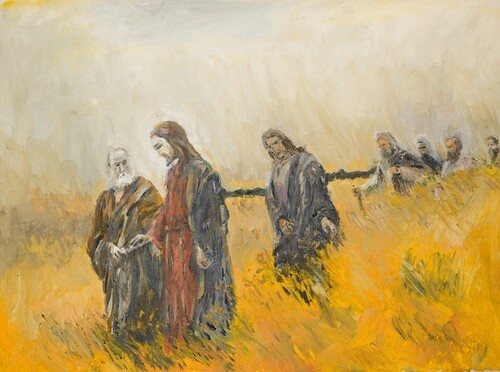The traditional interpretation of a type involves seeing a historical person, place, event, or institution as having a future historical fulfillment. The primary person, story, or event is the type, whereas the fulfillment is the antitype. In the New Testament, the Greek word týpos, meaning “example,” describes a model or pattern in the Old Testament that is fulfilled in the life and mission of Jesus Christ.[1] The word týpos in the King James Version of the Bible is also translated as “pattern” (Titus 2:7; Hebrews 8:5), “form” (Romans 6:17), “print” (John 20:25), “ensample” (1 Corinthians 10:11), “fashion” (Acts 7:44), “figure” (Acts 7:43; Romans 5:14), and “manner” (Acts 23:25).
Types are molds, templates, patterns, and examples of spiritual realities. Types are historical persons or events that are different in kind from allegory or parable in that types refer to a literal object pointing to a literal fulfillment or antitype.
While comparisons and connections in allegories are more indirect and implicit, types are historical realities. The allegory of the olive tree in Jacob 5 is a classic example of the metaphorical concept of caring for an olive vineyard as it is compared to the literal scattering and gathering of the house of Israel. In contrast, an example of a type is the literal figure of Melchizedek as a king and a priest pointing to Jesus Christ as our literal king and priest (see Hebrews 7; Alma 13).[2]
When light shines upon an object, that object casts a shadow, which reaches beyond the place of the object. The characteristics of the projected shadow resemble the object itself. While many specifics of the real object are missing from the shadow, there is enough similarity to see that the shadow is an extension of the form of the object. Types and shadows may thus be used interchangeably to some degree. Recall that types link two or more historical persons or events through common characteristics. Shadows, on the other hand, connect two or more persons or events through common themes.
Alma connected themes in speaking to his son Helaman. Alma spoke of how obeying the compass called Liahona was a shadow of giving heed to the word of Christ. The principles governing the operation of the Liahona are the same principles that allow the word of God to function in our lives (Alma 37:43–47). Alma wrote, “I would that ye should understand that these things are not without a shadow; for as our fathers were slothful to give heed to this compass (now these things were temporal) they did not prosper; even so it is with things which are spiritual” (Alma 37:43).
We cannot emphasize enough how important it is to know that types and shadows in the scriptures point to Christ and His doctrine. An additional witness to Alma, King Benjamin, taught that “many signs, and wonders, and types, and shadows showed he unto them, concerning his coming; and also holy prophets spake unto them concerning his coming; and yet they hardened their hearts, and understood not that the law of Moses availeth nothing except it were through the atonement of his blood” (Mosiah 3:15).
Recognizing the types that foreshadow the fulfillment in Christ is one way of seeing the fulfillment of prophecy. An easy way of thinking about types and shadows is to remember the phrase “promise and fulfillment.” In this regard, types share many similarities with prophecy in the scriptures. We can see, as Elder M. Russell Ballard taught, “the repeating pattern of history in the lives of God’s children as recorded in the Old Testament. Time and again we see the cycle of righteousness followed by wickedness. Similarly, the Book of Mormon records that ancient civilizations of this continent followed exactly the same pattern.” [3] Prophecy is used in the scriptures both to warn and to instruct. “Those who cannot remember the past,” Harvard historian George Santayana said, “are condemned to repeat it.”[4]
Types and shadows are one way to see the prophetic hand of God governing the affairs of man. As we see such types and shadows, we are then enabled to see the past, so we are not condemned to repeat those events that brought heartache and pain. Types and shadows testify that “all things denote there is a God” (Alma 30:44) and that those details, types, and shadows serve the purpose of “pointing our souls to him” (Jacob 4:5). We are thus enabled to see what brings “peace in this world, and eternal life in the world to come” (D&C 59:23).
We believe that the journey of exaltation and eternal life is a journey that expands the mind, enriches the soul, and blesses us with peace and transformation. The Lord in His mercy has given us prophets and apostles to guide us to that end. He has also authorized those servants to administer the ordinances and covenants that enable the Holy Ghost to bring permanent change to our hearts.[5] Eventually, in the process of time, line upon line, precept upon precept, by keeping the commandments and pointing others to Christ we become a light to the world as He is the light of the world (Matthew 5:14–16). We receive His image in our countenances and, through Christ, become the embodiment of a type and shadow of Christ—a true reflection of Him.[6]
The Lord declared to Adam that “all things have their likeness, and all things are created and made to bear record of me” (Moses 6:63). All things, in heaven and earth, testify of the Father through the Son by the power of the Holy Ghost. It is our hope that the greatest illustration of that principle is in the lives of the Latter-day Saints. The Lord has restored His doctrine, priesthood, and the keys to direct that priesthood through the Prophet Joseph Smith. Those keys are operational today through modern prophets and apostles in The Church of Jesus Christ of Latter-day Saints. While the types and shadows of the Old Testament testify of Christ, we have the obligation, blessing, and covenant possibility of being the ultimate type and shadow of Him.
[1] 1 Corinthians 10:1–13; Romans 5:12–21; 1 Peter 2:18–22; Hebrews 8:5; 9:24.
[2] “All truth,” Elder Alexander B. Morrison said, “both spiritual and temporal, testifies of Him. When we learn to read the ‘signs, and wonders, and types, and shadows’ (Mosiah 3:15) properly, with the eyes of faith, we will realize that all of history, all of science, all of nature, all divinely revealed knowledge of any sort, testifies of Him. He is the very personification of truth and light, of life and love, of beauty and goodness” (“Nourish the Flock of Christ,” Ensign, May 1992). Further, Elder Bruce R. McConkie of the Quorum of the Twelve Apostles taught that “the whole law of Moses, with all its types and shadows, testified of the one who would come to save his people” (“The Seven Christs,” Ensign, Nov. 1982).
[3] “Learning the Lessons of the Past,” Ensign, May 2009.
[4] In Bartlett, Familiar Quotations, 703; cited in Ballard, “Learning the Lessons of the Past,” Ensign, May 2009.
[5] See Bednar, “Always Retain a Remission of Your Sins,” Ensign, May 2016.
[6] See Alma 5:14, 19; Moroni 7:43–48; 1 Corinthians 13:1–13; 2 Corinthians 3:18; 1 John 3:1–2.
Lead image from Shutterstock
Get more out of your Old Testament scripture study with Types and Shadows of the Old Testament, available at Deseret Book stores and on deseretbook.com.


